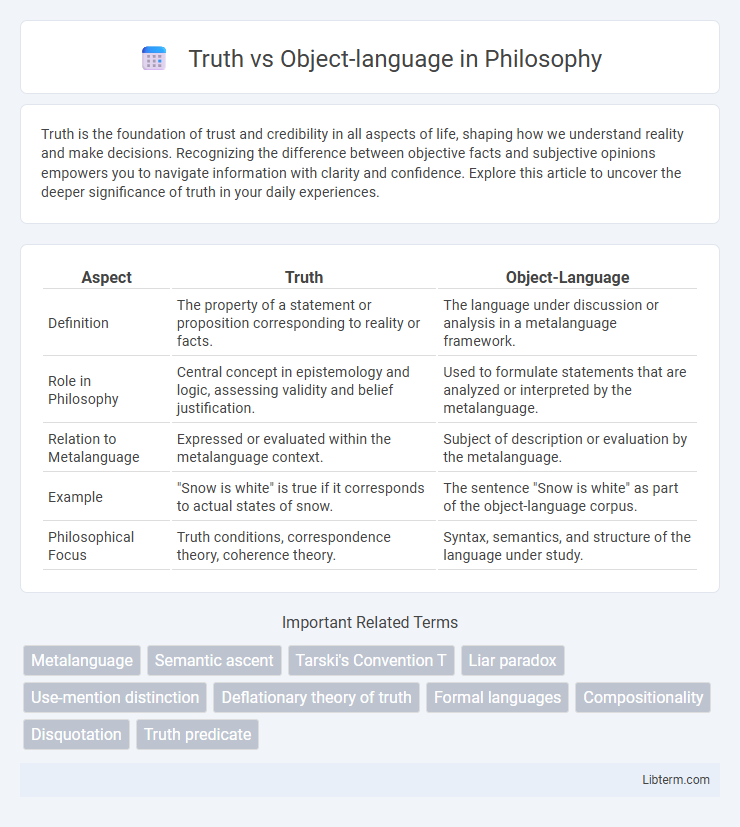Truth is the foundation of trust and credibility in all aspects of life, shaping how we understand reality and make decisions. Recognizing the difference between objective facts and subjective opinions empowers you to navigate information with clarity and confidence. Explore this article to uncover the deeper significance of truth in your daily experiences.
Table of Comparison
| Aspect | Truth | Object-Language |
|---|---|---|
| Definition | The property of a statement or proposition corresponding to reality or facts. | The language under discussion or analysis in a metalanguage framework. |
| Role in Philosophy | Central concept in epistemology and logic, assessing validity and belief justification. | Used to formulate statements that are analyzed or interpreted by the metalanguage. |
| Relation to Metalanguage | Expressed or evaluated within the metalanguage context. | Subject of description or evaluation by the metalanguage. |
| Example | "Snow is white" is true if it corresponds to actual states of snow. | The sentence "Snow is white" as part of the object-language corpus. |
| Philosophical Focus | Truth conditions, correspondence theory, coherence theory. | Syntax, semantics, and structure of the language under study. |
Defining "Truth" in Philosophy
Defining "truth" in philosophy involves distinguishing between the object-language, where statements are made, and the metalanguage, where those statements are analyzed and evaluated. Truth is often treated as a property ascribed to propositions within the metalanguage, enabling the assessment of their correspondence to reality or coherence within a system. Philosophical theories, such as the correspondence, coherence, and deflationary theories, explore how truth operates across these linguistic layers, emphasizing the semantic relationship between language and truth conditions.
Understanding Object-Language
Understanding object-language involves recognizing it as the language that is directly described or analyzed within another language, called the metalanguage. Object-language consists of the symbols, expressions, and rules that form the basis for constructing meaningful statements, which metalanguage uses to discuss or evaluate those statements. Mastering object-language is crucial for semantic analysis, as it allows for precise interpretation and manipulation of sentences without ambiguity inherent in natural language.
Origins of the Truth vs Object-Language Debate
The origins of the Truth vs Object-Language debate trace back to Alfred Tarski's seminal 1930 work on formal languages and semantics, where he distinguished between the object-language being studied and the metalanguage used to describe its truth conditions. Tarski's Convention T emphasized that truth must be defined in a metalanguage to avoid semantic paradoxes like the Liar paradox, highlighting the necessity of separating language levels. This foundational distinction reshaped modern logic and philosophy of language by clarifying how truth predicates operate within and across linguistic frameworks.
The Role of Tarski’s Semantic Theory of Truth
Tarski's semantic theory of truth revolutionized the understanding of the relationship between truth and object-language by formalizing the concept that truth is a property of sentences within a given language, not the language itself. His Convention T, central to this theory, establishes a criterion ensuring that the truth predicate corresponds accurately to the statements of the object-language, avoiding semantic paradoxes such as the liar paradox. This framework allows for a rigorous mathematical treatment of truth, enabling clearer distinctions between the metalanguage used to talk about truth and the object-language where propositions reside.
Object-language vs Metalanguage: Clarifying the Distinction
Object-language refers to the language being studied or analyzed, containing statements and expressions subjected to evaluation, while metalanguage is the language used to describe or discuss the object-language itself. This distinction allows for clear semantic analysis by separating the level at which expressions are constructed from the level used for commentary or interpretation. Understanding this hierarchy is essential to avoid semantic paradoxes and to formalize concepts such as truth within logical systems.
Common Misconceptions about Object-Language and Truth
Object-language refers to the language being studied or described, while truth relates to the semantic property of statements within that language. A common misconception is that truth can be universally defined within the object-language itself, overlooking that truth often requires a meta-language for proper semantic evaluation. Another frequent error is conflating object-language expressions with their truth values, failing to distinguish between linguistic structures and their semantic interpretations.
Truth Predicates and Their Usage in Object-Language
Truth predicates serve as meta-linguistic tools that allow statements about the truth of object-language sentences to be expressed within a meta-language. Their usage in object-language often leads to semantic paradoxes such as the Liar Paradox, highlighting limitations in self-referential truth assertions. Careful formalization in logical frameworks, like Tarski's hierarchy, is essential to maintain semantic coherence when incorporating truth predicates.
Semantic Paradoxes: The Liar Paradox Revisited
Semantic paradoxes, such as the Liar Paradox, expose fundamental tensions between truth and object-language by demonstrating sentences that assert their own falsehood, leading to logical inconsistencies. Revisiting the Liar Paradox highlights the limitations of classical truth definitions in object-language systems, prompting the development of hierarchical or non-classical semantic frameworks. These frameworks, including Tarski's theory of truth and Kripke's fixed-point models, aim to resolve paradoxes by distinguishing between object-language and meta-language levels.
Relevance of Truth and Object-Language in Modern Logic
Truth in modern logic serves as the fundamental criterion for evaluating the validity of propositions within an object-language, the formal language under scrutiny. The interaction between truth and object-language is pivotal in distinguishing semantic content from syntactic structure, enabling precise interpretations and formal proofs. Contemporary logical frameworks leverage this relationship to enhance model theory, automate reasoning processes, and refine the semantics of formal systems.
Implications for Analytic Philosophy and Linguistics
The distinction between truth and object-language underpins key debates in analytic philosophy, particularly in the work of Tarski and the development of formal semantics, shaping how truth conditions are expressed within languages versus languages about languages. This differentiation influences the meta-theoretical analysis of language, facilitating precise characterizations of meaning and reference crucial for linguistic theory and logical positivism. Understanding these implications advances the rigorous study of syntax, semantics, and the philosophy of language, reinforcing the foundational frameworks that support analytic philosophy and contemporary linguistic inquiry.
Truth Infographic

 libterm.com
libterm.com